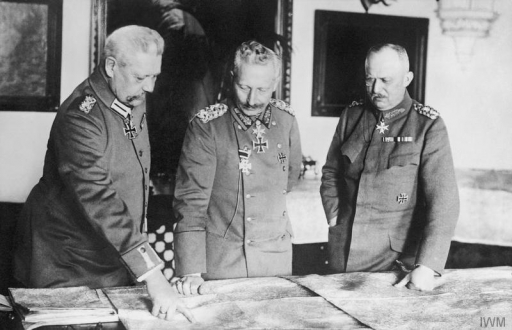Field Marshal Paul von Hindenburg and General Erich Ludendorff took over command of the German Army on August 29th 1916, dominating Germany’s military leadership for the rest of the First World War.
They replaced General Erich von Falkenhayn, whose fortunes were flagging after six months of attrition against France at Verdun.
Hindenburg and Ludendorff had established themselves as a popular duo since defeating Russia at the Battle of Tannenberg in the opening weeks of the war.
Romania’s entry into the Great War in August 1916 was the cue for Falkenhayn’s demotion from Chief of the General Staff to a new command in the Balkans, where he proved a success against the Romanians with General August von Mackensen.
Hindenburg succeeded him as army chief with his deputy, Ludendorff, as the driving force behind strategy.
The reshuffle of Germany’s top military leadership was the first since September 1914 when Falkenhayn took charge as the German advance stalled at the Battle of the Marne.
Paul von Hindenburg, a veteran of the Franco-Prussian War, had been called out of retirement at the start of WW1 to counter the Russian invasion of East Prussia.
The victory at Tannenberg in August 1914 reinforced his reputation, together with that of Ludendorff. Together they formed a formidable partnership on the Eastern Front, often at odds with the Chief of Staff, Falkenhayn.
Once in overall command, they ordered the construction of new defensive positions in the West in 1916-17. The Siegfried Stellung (or Hindenburg Line in English) allowed the German line in France to be shortened and strengthened.
Under Hindenburg and Ludendorff, Germany launched its final push for victory on the Western Front in spring 1918, initially catching the Allies off guard. It was Ludendorff who declared the start of the ultimately successful Allied counter-attack at Amiens in August to be ‘the black day of the German Army.’
After the Romanian campaign, Erich von Falkenhayn was sent to command Ottoman forces in Palestine in 1917.
Paul von Hindenburg went on to become President of Germany in 1925, appointing Adolf Hitler as Chancellor in January 1933.
Source: Wikipedia/various
Images courtesy of Imperial War Museums © IWM (Q 23746)
Posted by: CN Editorial Team
